Script for Laboratory: Designing embedded ASIPs - CES
Script for Laboratory: Designing embedded ASIPs - CES
Script for Laboratory: Designing embedded ASIPs - CES
You also want an ePaper? Increase the reach of your titles
YUMPU automatically turns print PDFs into web optimized ePapers that Google loves.
9.2 Speedup calculation<br />
t1<br />
t1<br />
t1<br />
2<br />
2<br />
Cycles<br />
2 Cycles<br />
2<br />
Cycles<br />
Cycles<br />
3<br />
3<br />
Cycles<br />
3 Cycles<br />
3<br />
Cycles<br />
Cycles<br />
1<br />
1<br />
Cycle<br />
1 Cycle<br />
1<br />
Cycle<br />
Cycle<br />
px_5<br />
px_5<br />
px_5<br />
2<br />
2<br />
Cycles<br />
2 Cycles<br />
2<br />
Cycles<br />
Cycles<br />
y_3<br />
y_3<br />
y_3<br />
Figure 9-2<br />
Rough estimated cycle counts <strong>for</strong> the custom instruction<br />
Figure 9-3<br />
A custom instruction with control structure<br />
A very easy example to show the speed up of an application has been shown in the<br />
Figure 9-2. We have taken a very simplistic assumption <strong>for</strong> calculating the speedup. Load<br />
takes two cycles, multiplication takes 3 cycles and an addition takes one cycle. The custom<br />
instruction shown in Figure 9-1 should take 8 software cycles but if we implement this group<br />
- 86 -
















